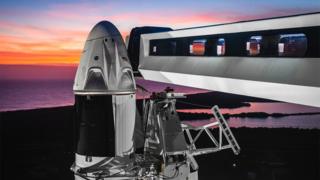 Image copyright
SPACEX
Image copyright
SPACEX
The US is about to take a major step towards being able to fly its astronauts into space once again.
California's SpaceX firm is performing a demonstration of a new rocket and capsule system, which, if it works well, will be approved to carry people.
Routine missions to the space station could start later this year.
Not since the retirement of the shuttles in 2011 has America been able to put humans in orbit. It's had to pay to use Russian Soyuz vehicles instead.
SpaceX's Falcon 9 rocket and Dragon crew capsule are scheduled to lift off from Florida's Kennedy Space Center at 02:49 EST Saturday (07:49 GMT).
The launch will occur from the historic Pad 39A where Apollo left for the Moon and Atlantis began the very last shuttle ascent.
Because this is just a demonstration, there are no astronauts aboard - but there will be a space-suited mannequin.
This test dummy, nicknamed Ripley after the Sigourney Weaver character in the Alien movies, will be covered in sensors.
These will record the forces and the environment experienced inside the capsule.
For SpaceX, this flight is a key milestone in its 17-year history. It was set up by entrepreneur Elon Musk with the specific intention of taking people beyond Earth.
"Human spaceflight is basically the core mission of SpaceX," explained Hans Koenigsmann, the company's vice president of build and flight reliability.
"There is nothing more important for us than this endeavour, and we really appreciate the opportunity from Nasa to do this."
The Falcon rocket is the same vehicle the company uses to loft cargo to the International Space Station and to put satellites in orbit. It's gone through many iterations down the years but now has an extensive flight history.
The crew capsule is based on the ISS cargo freighter but incorporates life-support systems and more powerful thrusters to push the vessel to safety if something goes wrong with the rocket. It also has four parachutes instead of the freighter's three to control the descent to Earth.
Dragon crew capsules will splashdown in the Atlantic not far from Kennedy.
Nasa is essentially now contracting out crew transport to SpaceX.
Whereas in the past, agency engineers would have top-down control of all aspects of vehicle design and Nasa would own and operate the hardware - the relationship with industry has been put on a completely new footing.
Today, Nasa sets broad requirements and industry is given plenty of latitude in how it meets those demands.
Agency officials still check off every step, but the approach is regarded as faster, more efficient and less costly.
"I fully expect we're going to learn something on this flight," said Bill Gerstenmaier, Nasa's head of human spaceflight.
"I guarantee that not everything will work exactly right. That's cool. That's exactly what we want to do.
"We want to maximise our learning so we can get this stuff ready so that when we put crew on, we're ready to go do a real crew mission, and it'll be the right safety for our crews."
Jonathan.Amos-INTERNET@bbc.co.uk and follow me on Twitter: @BBCAmos